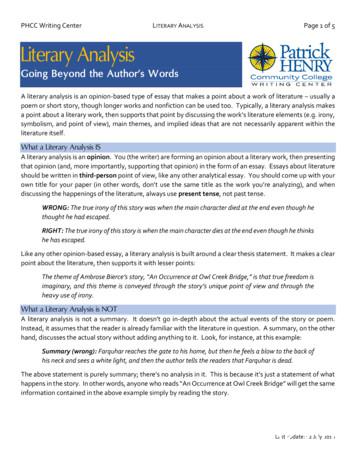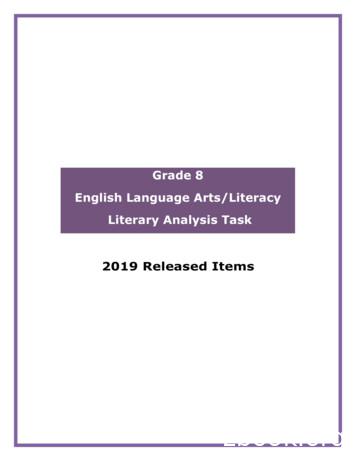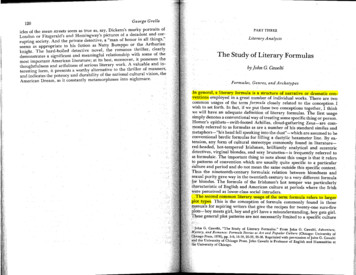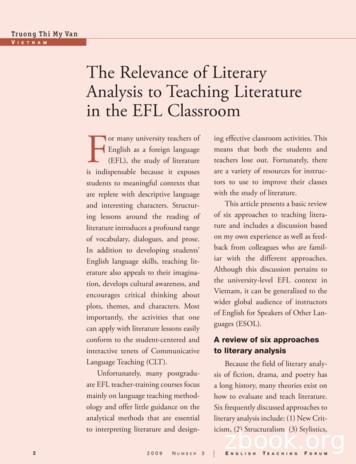A Guide To Basic Literary Theory: What Every English Major .
1A Guide to Basic Literary Theory: What Every English Major Should KnowWhat distinguishes an English major from a casual reader? English majors and other advanced students ofthe field of English studies recognize and pay particular attention to the way that language affectsmeaning. Where a casual or practical reader reads the surface of a text to understand the basic content andto find the immediately obvious meaning communicated in any text, a student of English studies looksdeeper. English majors identify and explore the multiple effects, influences, and implied meanings createdby the particular way language is used.If you have ever had a heated conversation with a friend or family member, you know that language doesnot always convey transparently exactly what we are thinking, and even the most innocently intendedcomment can be interpreted differently by audiences who notice different connotations in the choice ofwords. English majors study the way that meaning is created in that exchange between writers/speakers,readers/listeners, and the complexity of language itself. We use literary theory to help us uncover andmake sense of those subtle, below-the-surface effects of language.Literary theory does not mean making hypotheses orguesses about literature. In the field of English studies (andmost academic disciplines), theory refers to the study of theunderlying assumptions we make about the nature oflanguage, authors, readers, texts, human subjectivity,narrative, aesthetics, power, culture, and other major elementsof literary production and reception. The practical applicationof these theories emerges in literary criticism, where wemake concrete arguments often supported by close readingsof textual details about the way our underlying assumptionsplay out in a particular text or texts.Literary theory includes schools of thought and a set of often abstract and philosophical writings that helpus decide how we want to approach a text based on our definitions of literature and its function in theworld: Is literature about culture, society, differences among different groups of people? Is it about the beauty of language, the imagination, authorship and originality, or the creation ofword-based art? Is it about status, elitism, high culture, belles lettres, or just plain self-expressionin its most democratic and egalitarian sense? Is it about the possibilities or failures of communication or representation through language? Is it about the human psyche and what it reveals or hides with words? Is it about identity and therepresentation of characters as a key to figuring out what it is to be human? Is it about history—either making it, reflecting it, or reshaping it?Literary theorists write books and articles that give us useful terminology for explaining these conceptsthat are embedded deep within the literature we read. The following list identifies key theoreticalquestions, theories, and theorists who may help you explain and refine the underlying assumptions youDeveloped by Dr. Celena E. Kusch, USC Upstate, Fall 2016. This work is licensed under a CreativeCommons Attribution-NonCommercial-ShareAlike 4.0 International License. CC BY-NC-SA 4.0.
2already make when reading and analyzing literature. Use these broad definitions of literary theories tohelp guide your own deeper research into those theoretical questions that are most meaningful to you.Combining theories and drawing connections across theoretical schools and major concepts is a commonway for today’s critics to add their own contribution to the critical conversation.Theoretical Question 1: Is literature fundamentally about culture, society, anddifferences among different groups of people?Major Theoretical Concepts: Challenging assumptions about humandifferences, especially those relating to genderand sexuality, race, ethnicity, and nationality Overturning social hierarchies and redefininghuman differences as an effect of culturalpractices and power dynamics, not intellectual,physical, or other innate limitations Exposing the ways that literature of the past hasdepended upon inequalities to produce literarygenres and establish cultural and social power Promoting literature of resistance that givesvoice to diverse cultural positions to betteralign literature with political justice andcultural truthExamples of Theorists and Theoretical Movements/Schools Feminist literary theory, including Virginia Woolf’s A Room of One’s Own (1929), Simone deBeauvoir’s The Second Sex (1953), Elaine Showalter’s A Literature of Their Own: British WomenNovelists from Brontë to Lessing (1977), and Sandra Gilbert and Susan Gubar’s The Madwoman inthe Attic: The Woman Writer and the Nineteenth-century Literary Imagination (1979) Gender theory and queer theory, including bell hooks’s Feminist Theory: From Margin to Center(1984), Eve Kosofsky Sedgwick’s Between Men: English Literature and Male Homosocial Desire(1985), and Judith Butler’s Gender Trouble: Feminism and the Subversion of Identity (1990) Theories of African diasporic Négritude and African American studies, including W.E.B.DuBois’s The Souls of Black Folk (1903), Langston Hughes’s “The Negro Artist and the RacialMountain” (1926), Aimé Césaire’s Notebook of a Return to the Native Land (1939), Gloria T. Hull,Patricia Bell Scott, and Barbara Smith’s But Some of Us Are Brave: Black Women’s Studies (1982),Henry Louis Gates’s “Writing ‘Race’ and the Difference It Makes” (1985), Barbara Christian’s BlackFeminist Criticism: Perspectives on Black Women Writers (1985), Paul Gilroy’s The Black Atlantic(1995) Theories of mestizaje and multiethnic studies, including Gloria Anzaldúa’s Borderlands/LaFrontera: The New Mestiza (1987), Arnold Krupat’s The Voice in the Margin: Native AmericanLiterature and the Canon (1989), Shirley Geok-lin Lim and Amy Ling’s Reading the Literatures ofAsian America (1992)Developed by Dr. Celena E. Kusch, USC Upstate, Fall 2016. This work is licensed under a CreativeCommons Attribution-NonCommercial-ShareAlike 4.0 International License. CC BY-NC-SA 4.0.
3 Theories of intersectionality and critical race theory: Kimberlé Williams Crenshaw’s CriticalRace Theory: The Key Writings that Formed the Movement (1995), and Richard Delgado and JeanStefanic’s Critical Race Theory: An Introduction (2001)Postcolonial theory, including Frantz Fanon’s Black Skin, White Masks (1952) and The Wretched ofthe Earth (1961), Edward Said’s Orientalism (1978), Gayatri Spivak’s “Can the Subaltern Speak”(1988), Kwame Anthony Appiah’s In My Father’s House: Africa in the Philosophy of Culture (1992),and Homi Bhabha’s The Location of Culture (1994)Theoretical Question 2: Is literature about the beauty of language, theimagination, authorship and originality, or the creation of word-based art? Isit about status, elitism, high culture, belles lettres, or just plain self-expressionin its most democratic and egalitarian sense?Major Theoretical Concepts: Defining structures, genres, formalcharacteristics, moral and didactic purposes,and various functions and effects of literarytexts. Distinguishing the “literary” from everythingelse due to its “nobility” or its“defamiliarization” of normal language (esp.important to theorists in the school of RussianFormalism) Exploring the nature of inspiration, genius,originality, and authorship Considering the relationship between authors,language, society, and the texts they produce,Figure 1 By Jorge Royan / http://www.royan.com.ar, CC BY-SA d 19135725especially through concepts like the authorfunction and intertextuality Focusing on the ways that formal elements of literature create a coherent meaning that is deeper andmore profound than everyday language could express (esp. important in New Criticism). Rethinking and questioning divisions between elite or “high-brow” literature and popular culturetexts, such as television, film and popular cultureExamples of Theorists and Theoretical Movements/Schools Classical literary theory, such as Aristotle’s Poetics (c. 335 BCE) Longinus’s On the Sublime (1st century CE) Renaissance theories like Sir Philip Sidney’s “An Apology for Poetry” (1595) Neoclassical literary theory, including John Dryden’s An Essay of Dramatick Poesie (1668) orAlexander Pope’s An Essay on Criticism (1711) Romanticism, including William Wordsworth’s preface to Lyrical Ballads with Other Poems (1800)and Percy Bysshe Shelley’s “Defense of Poetry” (1821) Matthew Arnold’s Essays in Criticism (1865)Developed by Dr. Celena E. Kusch, USC Upstate, Fall 2016. This work is licensed under a CreativeCommons Attribution-NonCommercial-ShareAlike 4.0 International License. CC BY-NC-SA 4.0.
4 New Criticism, including Cleanth Brook’s The Well Wrought Urn (1947) and John Crowe Ransom’sThe New Criticism (1941)Practical Criticism, including F. R. Leavis’s For Continuity (1933) and I. A. Richards’s Principlesof Literary Criticism (1924)Formalism or Russian Formalism, including Viktor Shklovsky’s Theory of Prose (1925) andVladimir Propp’s Morphology of the Folktale (1928)Narratology, including Gérard Genette’s Narrative Discourse: An Essay in Method (1967-70 inFrench, 1980 in English) and Tzvetan Todorov’s The Poetics of Prose (1971)Structuralism, including Claude Lévi-Strauss’s Structural Anthropology (1958, translated 1963) andThe Raw and the Cooked (1964, translated in 1969), as well as Roland Barthes’s “An Introduction toa Structural Analysis of Narrative” (1975)Post-structuralism, including Roland Barthes’s “The Death of the Author” (1967) and From Work toText (1971), Michel Foucault’s “What Is an Author? (1969), and Julia Kristeva’s Desire in Language:A Semiotic Approach to Literature and Art (1980)Cultural Studies, including Stuart Hall’s Encoding and Decoding in the Television Discourse (1973)and “Cultural Studies: Two Paradigms” (1980)Theoretical Question 3: Is literature about the possibilities or failures ofcommunication or representation through language?Major Theoretical Concepts: Debating the differences and similarities between words and the things themselves, the “real” worldand the world of the text Understanding the relationship betweenword and meaning, symbol systems, thesignifier of meaning and the thingsignified, often through the field oflinguistics Understanding the workings of varioussigns, texts, or other representations ofmeaning through culture or language(esp. in theories of semiotics) Questioning the arbitrary nature ofmeaning within language and exposingthe ways in which meaning seeps out ofand slips away from the words used torepresent it as well as the ways in which Figure 2 By User:MatthiasKabel - Own work, CC BY-SA 3.0,all human knowledge is caught inside of https://commons.wikimedia.org/w/index.php?curid 5319651the imperfect language used to express it(there is nothing outside the text), esp. in the theory of deconstruction.Examples of Theorists and Theoretical Movements/Schools: Classicism, including concepts of imitation and mimesis in Aristotle’s Poetics (c. 335 BCE) andPlato’s Republic (c. 380 BCE)Developed by Dr. Celena E. Kusch, USC Upstate, Fall 2016. This work is licensed under a CreativeCommons Attribution-NonCommercial-ShareAlike 4.0 International License. CC BY-NC-SA 4.0.
5 Structuralism, including Ferdinand de Saussure’s Course in General Linguistics (1916)Semiotics, including Roland Barthes Mythologies (1972)Deconstruction, including Jacques Derrida’s Writing and Difference (1978)Reader-response Criticism, including Stanley Fish’s Is There a Text in This Class? The Authority ofInterpretive Communities (1980)Theoretical Question 4: Is literature about the human psyche and what itreveals or hides with words? Is literature about the nature of identity and therepresentation of characters as keys to figuring out what it means to behuman?Major Theoretical Concepts: Exploring the fundamental nature of identity, themind, the body, and the self, especially as it relatesto authors, readers, and invented or real characters. Analyzing the relationship between words and theunconscious fears, desires, and concerns of thepeople who attempt to express themselves inlanguage Exploring the effects of constructing the subject as“normal” in exclusive and exclusionary waysExamples of Theorists and TheoreticalMovements/Schools: Psychoanalytic criticism, include Sigmund Freud’s Interpretation of Dreams (1913) Poststructuralist psychoanalytic theory, including Jacques Lacan’s Écrits (1977) Feminist psychoanalytic theory, including Julia Kristeva’s Desire in Language: A SemioticApproach to Literature and Art (1980), Hélène Cixous’s “The Laugh of the Medusa” (1976), andLuce Irigaray’s Speculum of the Other Woman (1985) Disability studies, best exemplified by the essays in L. J. Davis’s The Disabilities Studies Reader(2013)Theoretical Question 5: Is literature about history—either making it,reflecting it, or reshaping it?Major Theoretical Concepts: Understanding the individual as a subject who can act withinlarger social structures, but who is also subjected to thedefinitions and expectations of economic and politicalinstitutions Defining literature as one of many cultural institutions thatinteract with the political and economic power of the timeand that narrate the relationship between individuals and theDeveloped by Dr. Celena E. Kusch, USC Upstate, Fall 2016. This work is licensed under a CreativeCommons Attribution-NonCommercial-ShareAlike 4.0 International License. CC BY-NC-SA 4.0.
6institutions of power in the world Untangling the ways in which literature is both shaped by and shapes history, sometimes resistingmainstream values and sometimes reinforcing those values.Examples of Theorists and Theoretical Movements/Schools: Marxist theory, including Georg Lukács’s The Theory of the Novel (1971), Frederic Jameson’sMarxism and Form (1971), Terry Eagleton’s Marxism and Literary Criticism (1976), and PierreMacherey’s A Theory of Literary Production (1978) New Historicism, including Stephen Greenblatt’s Renaissance Self-fashioning (1980), LouisMontrose’s “‘Shaping Fantasies’: Figurations of Gender and Power in Elizabethan Culture” (1983),and Catherine Gallagher and Stephen Greenblatt’s Practicing New Historicism (2000) Cultural Materialism, including Raymond Williams’s Culture and Society 1780-1950 (1958),Catherine Belsey’s The Subject ofTragedy: Identity and Difference inRenaissance Drama (1985), AndrewMilner’s Re-imagining CulturalStudies: The Promise of CulturalMaterialism (2002) Ideology theory, including LouisAlthusser’s Lenin and Philosophy,and Other Essays (1971) and SlavojŽižek’s The Sublime Object ofIdeology (1989) Discourse theories, includingMichel Foucault’s The Archaeologyof Knowledge and the Discourse onFigure 3 By Gobierno de la Ciudad de Buenos Aires from Ciudad Autónoma de Buenos Aires,Language (1972)Argentina - Torre de Babel, CC BY d 20231201 Ecocriticism, Dark Ecology, andPosthumanism, including CheryllGlotfelty and Harold Fromm The Ecocriticism Reader: Landmarks in Literary Ecology (1996),Richard Kerridge and Neil Sammels’s Writing the Environment: Ecocriticism and Literature 1998,Timothy Morton’s Ecology without Nature (2007) and The Ecological Thought (2010), and CaryWolfe What Is Posthumanism? (2010)Developed by Dr. Celena E. Kusch, USC Upstate, Fall 2016. This work is licensed under a CreativeCommons Attribution-NonCommercial-ShareAlike 4.0 International License. CC BY-NC-SA 4.0.
Literary theory does not mean making hypotheses or guesses about literature. In the field of English studies (and most academic disciplines), theory refers to the study of the underlying assumptions we make about the nature of language, authors, readers, texts, human subjectivity,
An Introduction to Literary Criticism and Theory Before we begin our examination and study of literary theory, it is important that we define exactly what literary theory is and is not, identify some of the main characteristics of such, as well as identify some of the key differences between traditional “literary criticism” and “literary theory.” While literary criticism since the late .
expository guide to literary criticism or literary concepts, nor does it attempt to catalogue the entire body of literary terms in use. It offers instead to clarify those thousand terms that are most likely to cause the student or general reader some doubt or bafflement in the context of literary criticism and other discussion of literary works.
Literary Analysis Sample Paper. A literary analysis is an argumentative analysis about a literary work. Although some summary is needed within the argument of a literary analysis, the objective is not to write a report about a book or story. Instead, a literary analysis discusses a writer’s interpretation of a text through
Literary Analysis Sample Paper August 2016 Provided by the Academic Center for Excellence 1. Literary Analysis Sample Paper. A literary analysis is an argumentative analysis about a literary work. Although some summary is needed within the argument of a literary analysis, the objective is not to write a report about a book or story.
Literary Analysis Sample Paper August 2016 Provided by the Academic Center for Excellence 1. Literary Analysis Sample Paper. A literary analysis is an argumentative analysis about a literary work. Although some summary is needed within the argument of a literary analysis, the objective is not to write a report about a book or story.
Introduction to Literary Criticism. Definition and Use “Literary criticism” is the name given to works written by experts who critique—analyze—an author’s work. It does NOT mean “to criticize” as in complain or disapprove. Literary criticism is often referred to as a “secondary source”. Literary Criticism and Theory Any piece of text can be read with a number of different .
Academic literary criticism prior to the rise of “New Criticism” in the United States tended to practice traditional literary history: tracking influence, establishing the canon of major writers in the literary periods, and clarifying historical context and allusions within the text. Literary biography was and still is an important interpretive method in and out of the academy; versions of .
literature itself. What a Literary Analysis IS A literary analysis is an opinion. You (the writer) are forming an opinion about a literary work, then presenting that opinion (and, more importantly, supporting that opinion) in the form of an essay. Essays about literature should be written in third-person point of view, like any other analytical .
ENG125: Introduction to Literature Critical Literary Theories Purpose: Use this resource to learn about literary criticism. What is literary criticism? Literary Critical Theory is a tool that helps you find meaning in stories, poems
Grade 8 English Language Arts/Literacy . Literary Analysis Task . English LanguageArts/Literacy . 2019 Released Items: Grade 8 Literary Analysis Task The Literary Analysis Task requires students to read two literary texts that are purposely p
The premise of Literary Theory: The Basicsis that literary theory and literary practice - the practice of interpretation - cannot indeed very well be separated, and certainly not at the more advanced level of academic literary studies. One of its aims, then, is to show how theory and practice are inevitably connected and have always been .
Terry Eagleton (T errence Francis Eagleton) is a contemporary literary scholar and a prominent cultural theorist, widely regarded as the one of the foremost Marxist literary critics. With the publication of Marxism and Literary Criticism , and Literary Theory, a popular college text, Eagleton won recognition for producing erudite works of literary
work/products (Beading, Candles, Carving, Food Products, Soap, Weaving, etc.) ⃝I understand that if my work contains Indigenous visual representation that it is a reflection of the Indigenous culture of my native region. ⃝To the best of my knowledge, my work/products fall within Craft Council standards and expectations with respect to
A Reader’s Guide to Contemporary Literary Theoryis a classic introduction to the ever-evolving field of modern literary theory, now expanded and updated in its fifth edition. This book presents the full range of positions and movements in contemporary literary theory. It organises the theories into clearly defined sections and presents them in an accessible and lucid style. Students are .
MOUNT ASPIRING COLLEGE DEPARTMENT OF ENGLISH - FEMINIST LITERARY CRITICISM - PAGE !3 OF !7. WHAT MARXIST CRITICS DO TAKEN FROM BEGINNING THEORY, BY P. BARRY2: 1. They make a division between the ‘overt’ (manifest or surface) and ‘covert’ (latent or hidden) content of a literary work (much as psychoanalytic critics do) and then relate the covert subject matter of the literary work to .
Literary Analysis The Study of Literary Formulas by fohn G. Cawelti Formulas, Genres, and Archetypes In general, a literary formula is a structure of narrative or dramatic con ventions employed in a great number of individual works. There are two common usages of the term formula closely related to the conception_ I wish to set forth.
to literary analysis. Because the field of literary analy-sis of fiction, drama, and poetry has a long history, many theories exist on how to evaluate and teach literature. Six frequently discussed approaches to literary analysis include: (1) New Crit-icism, (2) Structuralism, (3) Stylistics,
Introduction: What Is Literary Theory and Why Should I Care? LEARNING OBJECTIVES. 1. Examine the kinds of questions that literary theories attempt to answer. 2. Explore the relevance of literary theory to undergraduate studies. 3. Review the steps of the writing process. 4. Develop a plan
“The Tell-Tale Heart” Literary Response English 8 Prompt: Describe in a literary response essay how the author creates suspense throughout the characters, setting, and plot. Assignment: In response to this prompt, you will write a 5-paragraph literary response essay.
Literary Terms Chris Baldick is Professor of English at Goldsmiths' College, University of London. He edited The Oxford Book of Gothic Tales (1992), and is the author of In Frankenstein's Shadow (1987), Criticism and Literary Theory 1890 to the Present (1996), and other works of literary history. He has edited, with Rob Morrison,



































